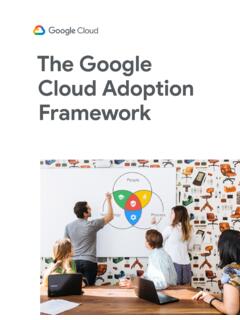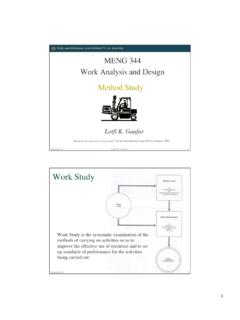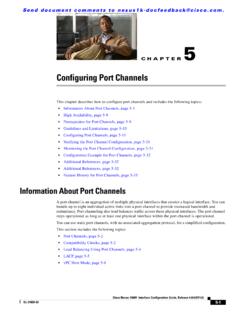Transcription of Google Cloud Security Whitepapers
1 1 Google CloudSecurityWhitepapersGoogle Cloud Infrastructure Security Design Overview March 2018 Encryption at Rest in Google Cloud Encryption in Transit in Google Cloud Application Layer Transport Security in Google Cloud2 Table of ContentsGoogle Cloud Infrastructure Security Design Overview ..3 Encryption at Rest in Google Cloud ..23 Encryption in Transit in Google Cloud ..43 Application Layer Transport Security in Google Cloud ..753 A technical whitepaper from Google Cloud4 Table of ContentsIntroduction ..7 Secure Low Level Infrastructure ..8 Security of Physical PremisesHardware Design and Provenance Secure Boot Stack and Machine Identity Secure Service Deployment ..9 Service Identity, Integrity, and Isolation Inter-Service Access Management Encryption of Inter-Service Communication Access Management of End User Data Secure Data Storage.
2 14 Encryption at Rest Deletion of Data Secure Internet Communication ..15 Google Front End Service Denial of Service (DoS) Protection User Authentication Operational Security ..17 Safe Software Development Keeping Employee Devices and Credentials Safe Reducing Insider Risk Intrusion Detection 5 Securing the Google Cloud Platform (GCP) ..19 Conclusion ..21 Additional Reading ..22 The content contained herein is correct as of January 2017, and represents the status quo as of the time it was s Security policies and systems may change going forward, as we continually improve protection for our summary Google has a global scale technical infrastructure designed to provide Security through the entire information processing lifecycle at Google .
3 This infrastructure provides secure deployment of services, secure storage of data with end user privacy safeguards, secure communications between services, secure and private communication with customers over the internet, and safe operation by administrators. Google uses this infrastructure to build its internet services, including both consumer services such as Search, Gmail, and Photos, and enterprise services such as G Suite and Google Cloud Platform. The Security of the infrastructure is designed in progressive layers starting from the physical Security of data centers, continuing on to the Security of the hardware and software that underlie the infrastructure, and finally, the technical constraints and processes in place to support operational Security .
4 Google invests heavily in securing its infrastructure with many hundreds of engineers dedicated to Security and privacy distributed across all of Google , including many who are recognized industry document gives an overview of how Security is designed into Google s technical infrastructure. This global scale infrastructure is designed to provide Security through the entire information processing lifecycle at Google . This infrastructure provides secure deployment of services, secure storage of data with end user privacy safeguards, secure communications between services, secure and private communication with customers over the internet, and safe operation by administrators. Google uses this infrastructure to build its internet services, including both consumer services such as Search, Gmail, and Photos, and enterprise services such as G Suite and Google Cloud will describe the Security of this infrastructure in progressive layers starting from the physical Security of our data centers, continuing on to how the hardware and software that underlie the infrastructure are secured, and finally, describing the technical constraints and processes in place to support operational Infrastructure Security Layers[Figure 1] Google Infrastructure Security LayersThe various layers of Security starting from hardware infrastructure at the bottom layer up to operational Security at the top layer.
5 The contents of each layer are described in detail in the Low Level InfrastructureIn this section we describe how we secure the lowest layers of our infrastructure, ranging from the physical premises to the purpose-built hardware in our data centers to the low-level software stack running on every of Physical Premises Google designs and builds its own data centers, which incorporate multiple layers of physical Security protections. Access to these data centers is limited to only a very small fraction of Google employees. We use multiple physical Security layers to protect our data center floors and use technologies like biometric identification, metal detection, cameras, vehicle barriers, and laser-based intrusion detection systems.
6 Google additionally hosts some servers in third-party data centers, where we ensure that there are Google -controlled physical Security measures on top of the Security layers provided by the data center operator. For example, in such sites we may operate independent biometric identification systems, cameras, and metal Design and ProvenanceA Google data center consists of thousands of server machines connected to a local network. Both the server boards and the net-working equipment are custom-designed by Google . We vet component vendors we work with and choose components with care, while working with vendors to audit and validate the Security proper-ties provided by the components. We also design custom chips, including a hardware Security chip that is currently being deployed on both servers and peripherals.
7 These chips allow us to securely iden-tify and authenticate legitimate Google devices at the hardware Boot Stack and Machine IdentityGoogle server machines use a variety of technologies to ensure that they are booting the correct software stack. We use cryptographic A Google data center consists of thousands of server machines connected to a local network . Both the server boards and the networking equipment are custom designed by Google .9signatures over low-level components like the BIOS, bootloader, kernel, and base operating system image. These signatures can be validated during each boot or update. The components are all Google -controlled, built, and hardened. With each new generation of hardware we strive to continually improve Security : for example, depending on the generation of server design, we root the trust of the boot chain in either a lockable firmware chip, a microcontroller running Google -written Security code, or the above mentioned Google -designed Security server machine in the data center has its own specific identity that can be tied to the hardware root of trust and the software with which the machine booted.
8 This identity is used to authenticate API calls to and from low-level management services on the has authored automated systems to ensure servers run up-to-date versions of their software stacks (including Security patches), to detect and diagnose hardware and software problems, and to remove machines from service if necessary. Secure Service Deployment We will now go on to describe how we go from the base hardware and software to ensuring that a service is deployed securely on our infra-structure. By service we mean an application binary that a developer wrote and wants to run on our infrastructure, for example, a Gmail SMTP server, a BigTable storage server, a YouTube video transcoder, or an App Engine sandbox running a customer application.
9 There may be thousands of machines running copies of the same service to handle the required scale of the workload. Services running on the infrastructure are controlled by a cluster orchestration service called Borg. As we will see in this section, the infrastructure does not assume any trust between services running on the infrastructure. In other words, the infrastructure is fundamentally designed to be Identity, Integrity, and IsolationWe use cryptographic authentication and authorization at the application layer for inter-service communication. This provides strong access control at an abstraction level and granularity that administrators and services can naturally do not rely on internal network segmentation or firewalling as our primary Security mechanisms, though we do use ingress and egress filtering at various points in our network to prevent IP spoofing as a further Security layer.
10 This approach also helps us to maximize our network s performance and service that runs on the infrastructure has an associated service account identity. A service is provided cryptographic credentials that it can use to prove its identity when making or receiving remote procedure calls (RPCs) to other services. These identities are used by clients to ensure that they are talking to the correct intended server, and by servers to limit access to methods and data to particular s source code is stored in a central repository where both current and past versions of the service are auditable. The infrastruc-ture can additionally be configured to require that a service s binaries be built from specific reviewed, checked in, and tested source code.














